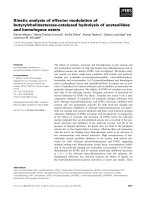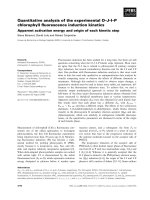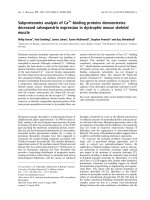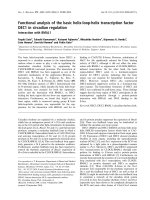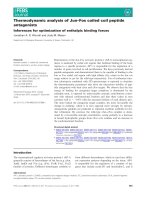Báo cáo khoa học: "Semantic Analysis of Japanese Noun Phrases: A New Approach to Dictionary-Based Understanding" doc
Bạn đang xem bản rút gọn của tài liệu. Xem và tải ngay bản đầy đủ của tài liệu tại đây (640.77 KB, 8 trang )
Semantic Analysis of Japanese Noun Phrases :
A New Approach to Dictionary-Based Understanding
Sadao Kurohashi and Yasuyuki
Sakai
Graduate School of Informatics, Kyoto University
Yoshida-honmachi, Sakyo, Kyoto, 606-8501, Japan
kuro0i, kyoto-u, ac. jp
Abstract
This paper presents a new method of analyz-
ing Japanese noun phrases of the form
N1 no
5/2. The Japanese postposition
no
roughly cor-
responds to
of,
but it has much broader us-
age. The method exploits a definition of N2
in a dictionary. For example,
rugby no coach
can be interpreted
as a person who teaches tech-
nique in rugby.
We illustrate the effectiveness
of the method by the analysis of 300 test noun
phrases.
1
Introduction
The semantic analysis of Japanese noun phrases
of the form
N1 no N2
is one of the difficult prob-
lems which cannot be solved by the current ef-
forts of many researchers. Roughly speaking,
Japanese noun phrase
N1 no N2
corresponds to
English noun phrase N2
of N1.
However, the
Japanese postposition
no
has much broader us-
age than
of as
follows:
watashi
'I'
no kuruma
'car'
tsukue
'desk'
no ashi
'leg'
gray no seihuku
'uniform'
possession
whole-part
modification
senmonka
'expert'
no chousa
'study'
agent
rugby no coach
subject
yakyu
'baseball'
no senshu
'player'
category
kaze
'cold'
no virus
result
ryokou
'travel'
no jyunbi
'preparation'
purpose
toranpu
'card'
no tejina
'trick' instrument
The conventional approach to this problem
was to classify semantic relations, such as pos-
session, whole-part, modification, and others.
Then, classification rules were crafted by hand,
or detected from relation-tagged examples by
a machine learning technique (Shimazu et al.,
1987; Sumita et al., 1990; Tomiura et al., 1995;
Kurohashi et al., 1998).
The problem in such an approach is to set
up the semantic relations. For example, the
above examples and their classification came
from the IPA nominal dictionary (Information-
Technology Promotion Agency, Japan, 1996).
Is it possible to find clear boundaries among
subject, category, result, purpose, instrument,
and others? No matter how fine-grained rela-
tions we set up, we always encounter phrases
which are on the boundary or belong to two or
more relations.
This paper proposes a completely different
approach to the task, which exploits
semantic
role information
of nouns in an ordinary dictio-
nary.
2 Semantic Roles of
Nouns
The meaning of a word can be recognized by
the relationship with its semantic roles. In the
case of verbs, the arguments of the predicates
constitute the semantic roles, and a consider-
able number of studies have been made. For
example, the case grammar theory is a semantic
valence theory that describes the logical form of
a sentence in terms of a predicate and a series
of case-labeled arguments such as agent, object,
location, source, goal (Fillmore, 1968). Further-
more, a wide-coverage dictionary describing se-
mantic roles of verbs in machine readable form
has been constructed by a great deal of labor
(Ikehara et al., 1997).
Not only verbs, but also nouns can have se-
mantic roles. For example,
coach
is a coach of
some sport; virus
is a virus causing
some dis-
ease.
Unlike the case of verbs, no semantic-
481
Table 1: Semantic relations in N1 no N2
Relation Noun Phrase N1 no N2 Verb Phrase
Semantic-role rugby no coach,
kaze 'cold' no virus,
tsukue 'desk' no ashi 'leg',
ryokou 'travel' no jyunbi 'preparation'
hon-wo 'book-Ace' yomu 'read'
Agent senmonka 'expert' no chousa 'study' kare-ga
'he-NOM'
yomu 'read'
Possession watashi 'I' no kuruma 'car'
Belonging gakkou 'school' no sensei 'teacher'
Time aki 'autumn' no hatake 'field' 3ji-ni 'at 3 o'clock' yomu 'read'
Place Kyoto no raise 'store' heya-de 'in room' yomu 'read'
Modification gray no seihuku 'uniform' isoide 'hurriedly' yomu 'read'
huzoku 'attached' no neji 'screw'
ki 'wooden' no hako 'box'
Complement kimono no jyosei 'lady'
nobel-sho 'Nobel prize' no kisetsu 'season'
role dictionary for nouns has been constructed
so far. However, in many cases, semantic roles
of nouns are described in an ordinary dictio-
nary for human being. For example, a Japanese
dictionary for children, Reikai Shougaku Koku-
gojiten (abbreviated to RSK) (Tadil~, 1997),
gives the definition of the word coach and virus
as follows 1:
coach a person who teaches technique in some
sport
virus a living thing even smaller than bacte-
ria which causes infectious disease like in-
fluenza
If an NLP system can utilize these definitions
as they are, we do not need to take the trou-
ble in constructing a semantic-role dictionary
for nouns in the special format for machine-use.
3 Interpretation
of N1 no N2
using a
Dictionary
Semantic-role information of nouns in an ordi-
nary dictionary can be utilized to solve the dif-
ficult problem in the semantic analysis of N1
1Although our method handles Japanese noun
phrases by using Japanese definition sentences, in this
paper we use their English translations for the explana-
tion. In some sense, the essential point of our method is
language-independent.
no N2 phrases. In other words, we can say the
problem disappears.
For example, rugby no coach can be inter-
preted by the definition of coach as follows: the
dictionary describes that the noun coach has an
semantic role of sport, and the phrase rugby no
coach specifies that the sport is rugby. That is,
the interpretation of the phrase can be regarded
as matching rugby in the phrase to some sport
in the coach definition. Furthermore, based on
this interpretation, we can paraphrase rugby no
coach into a person who teaches technique in
rugby, by replacing some sport in the definition
with rugby.
Kaze 'cold' no virus is also easily interpreted
based on the definition of virus, linking kaze
'cold' to infectious disease.
Such a dictionary-based method can handle
interpretation of most phrases where conven-
tional classification-based analysis failed. As a
result, we can arrange the diversity of N1 no N2
senses simply as in Table 1.
The semantic-role relation is a relation that
N1 fills in an semantic role of
N2.
When
N2
is
an action noun, an object-action relation is also
regarded as a semantic-role relation.
On the other hand, in the agent, posses-
sion and belonging relations, N1 and N2 have
a weaker relationship. In theory, any action can
be done by anyone (my study, his reading, etc.);
482
anything can be possessed by anyone (my pen,
his feeling, etc.); and anyone can belong to any
organization (I belong to a university, he be-
longs to any community, etc.).
The difference between the semantic-role re-
lation and the agent, possession, belonging rela-
tions can correspond to the difference between
the agent and the object of verbs. In general,
the object has a stronger relationship with a
verb than the agent, which leads several asym-
metrical linguistic phenomena.
The
time
and
place
relations have much
clearer correspondence to optional cases for
verbs. A
modification
relation is also parallel
to modifiers for verbs. If a phrase has a modi-
fication relation, it can be paraphrased into N2
is N1,
like
gray no seihuku
'uniform' is para-
phrased into
seihuku
'uniform'
is gray.
The last relation, the
complement
relation is
the most difficult to interpret. The relation be-
tween N1 and N2 does not come from Nl'S se-
mantic roles, or it is not so weak as the other
relations. For example,
kimono no jyosei
'lady'
means a lady wearing a kimono, and
nobel-sho
'Nobel prize'
no kisetsu
'season' means a sea-
son when the Nobel prizes are awarded. Since
automatic interpretation of the complement re-
lation is much more difficult than that of other
relations, it is beyond the scope of this paper.
4 Analysis Method
Once we can arrange the diversity of
N1
no N 2
senses as in Table 1, their analysis becomes very
simple, consisting of the following two modules:
1. Dictionary-based analysis (abbreviated to
DBA hereafter) for semantic-role relations.
2. Semantic feature-based analysis (abbrevi-
ated to SBA hereafter) for some semantic-
role relations and all other relations.
After briefly introducing resources employed,
we explain the algorithm of the two analyses.
4.1 Resources
4.1.1
RSK
RSK (Reikai Shougaku Kokugojiten), a
Japanese dictionary for children, is used to find
semantic roles of nouns in DBA. The reason
why we use a dictionary for children is that,
generally speaking, definition sentences of such
a dictionary are described by basic words,
which helps the system finding links between
N1 and a semantic role of a head word.
All definition sentences in RSK were analyzed
by JUMAN, a Japanese morphological analyzer,
and KNP, a Japanese syntactic and case ana-
lyzer (Kurohashi and Nagao, 1994; Kurohashi
and Nagao, 1998). Then, a genus word for a
head word, like
a person
for
coach
were detected
in the definition sentences by simple rules: in a
Japanese definition sentence, the last word is a
genus word in almost all cases; if there is a noun
coordination at the end, all of those nouns are
regarded as genus words.
4.1.2 NTT Semantic Feature
Dictionary
NTT Communication Science Laboratories
(NTT CS Lab) constructed a semantic feature
tree, whose 3,000 nodes are semantic features,
and a nominal dictionary containing about
300,000 nouns, each of which is given one or
more appropriate semantic features. Figure 1
shows the upper levels of the semantic feature
tree.
SBA uses the dictionary to specify conditions
of rules. DBA also uses the dictionary to cal-
culate the similarity between two words. Sup-
pose the word X and Y have a semantic feature
Sx
and
Sy,
respectively, their depth is
dx
and
dy
in the semantic tree, and the depth of their
lowest (most specific) common node is
de,
the
similarity between X and Y,
sire(X, Y),
is cal-
culated as follows:
sire(X, Y) = (dc x 2)/(dx + dy).
If
Sx
and
Sy
are the same, the similarity is 1.0,
the maximum score based on this criteria.
4.1.3 NTT Verb Case Frame
Dictionary
NTT CS Lab also constructed a case frame
dictionary for 6,000 verbs, using the semantic
features described above. For example, a case
frame of the verb
kakou-suru
(process) is as fol-
lows:
N1 (AGENT)-ga N2(CONCRETE)-wo
kako.u-suru
'N1 process N2'
where
ga
and
wo
are Japanese nominative and
accusative case markers. The frame describes
483
NOUN
CONCRETE
J
AGENT PLACE
/\
HUMAN ORGANIZATION
CONCRETE
ABSTRACT
J
ABSTRACT EVENT ABSTRACT RELATION
J/l\
TIME POSITION QUANTITY
Figure 1: The upper levels of NTT Semantic Feature Dictionary.
that the verb
kakou-suru
takes two cases, nouns
of
AGENT
semantic feature can fill the
ga-case
slot and nouns of CONCRETE semantic feature
can fill the wo-case slot. KNP utilizes the case
frame dictionary for the case analysis.
4.2 Algorithm
Given an input phrase
N1 no N2,
both DBA and
SBA are applied to the input, and then the two
analyses are integrated.
4.2.1 Dictionary-based Analysis
Dictionary based-Analysis (DBA) tries to find
a correspondence between N1 and a semantic
role of N2 by utilizing RSK, by the following
process:
1. Look up N2 in RSK and obtain the defini-
tion sentences of N2.
2. For each word w in the definition sentences
other than the genus words, do the follow-
ing steps:
2.1. When w is a noun which shows a
semantic role explicitly, like
kotog-
ara 'thing',
monogoto
'matter',
nanika
'something', and N1 does not have a
semantic feature of HUMAN
or TIME,
give 0.9 to their correspondence 2.
2.2. When w is other noun, calculate the
similarity between N1 and w by using
NTT Semantic Feature Dictionary (as
described in Section 4.1.2), and give
2For the present, parameters in the algorithm were
given empirically, not optimized by a learning method.
the similarity score to their correspon-
dence.
2.3. When w is a verb, it has a vacant case
slot, and the semantic constraint for
the slot meets the semantic feature of
N1, give 0.5 to their correspondence.
.
.
If we could not find a correspondence with
0.6 or more score by the step 2, look up the
genus word in the RSK, obtain definition
sentences of it, and repeat the step 2 again.
(The looking up of a genus word is done
only once.)
Finally, if the best correspondence score is
0.5 or more, DBA outputs the best corre-
spondence, which can be a semantic-role
relation of the input; if not, DBA outputs
nothing.
For example, the input
rugby no coach
is ana-
lyzed as follows (figures attached to words indi-
cate the similarity scores; the underlined score
is the best):
(1)
rugby no coach
coach a person who teaches technique0.21
in some sport 1.0
Rugby, technique
and
sport
have the semantic
feature SPORT,
METHOD and SPORT respectively
in NTT Semantic Feature Dictionary. The low-
est common node between SPORT and METHOD
is ABSTRACT,
and based on these semantic fea-
tures, the similarity between
rugby
and
tech-
nique
is calculated as 0.21. On the other hand,
484
the similarity between
rugby
and
sport
is calcu-
lated as 1.0, since they have the same seman-
tic feature. The case analysis finds that all case
slots of
teach
are filled in the definition sentence.
As a result, DBA outputs the correspondence
between
rugby
and
sport
as a possible semantic-
role relation of the input.
On the other hand,
bunsho
'writings'
no tat-
sujin
'expert' is an example that N1 corresponds
to a vacant case slot of the predicate
outstand-
ing:
(2)
bunshou
'writings'
no tatsujin
'expert'
expert
a person being outstanding (at
¢0.50)
Puroresu
'pro wrestling'
no chukei
'relay' is
an example that the looking up of a genus word
broadcast
leads to the correct analysis:
(3)
puroresu
'pro wrestling'
no chukei
'relay'
relay
a relay broadcast
broadcast
a radioo.o or televisiono.o
presentation of news 0.48,
entertainment 0.87, music o.so and
others
4.2.2 Semantic Feature-based Analysis
Since diverse relations in N1 no N2 are han-
dled by DBA, the remaining relations can be
detected by simple rules checking the semantic
features of N1 and/or N2.
The following rules are applied one by one to
the input phrase. Once the input phrase meets
a condition, SBA outputs the relation in the
rule, and the subsequent rules are not applied
any more.
1. NI:HUMAN, N2:RELATIVE ~ semantic-
role(relative)
e.g.
kare
'he'
no oba
'aunt'
2. NI:HUMAN, N2:PERSONAL._RELATION ~
semantic-role(personal relation)
e.g.
kare
'he'
no tomodachi
'friend'
3. NI:HUMAN,
N2:HUMAN ~ modifica-
tion(apposition)
e.g.
gakusei
'student'
no kare
'he'
4. NI:ORGANIZATION, N2:HUMAN ~ belong-
ing
e.g.
gakkou
'school'
no sensei
'teacher'
5. NI:AGENT, N2:EVENT ~
agent
e.g.
senmonka
'expert'
no chousa
'study'
6. NI:MATERIAL, N2:CONCRETE +
modifica-
tion(material)
e.g.
ki
'wood'
no hako
'box'
7. NI:TIME, N2:* 3 ___+
time
e.g.
aki
'autumn'
no hatake
'field'
8. NI:COLOR, QUANTITY, or FIGURE, g2:*
modification
e.g.
gray no seihuku
'uniform'
9. gl:*, N2:QUANTITY ~
semantic-role(at-
tribute)
e.g.
hei
'wall'
no takasa
'height'
10. gl:* , N2:POSITION ~
semantic-role(posi-
tion)
e.g.
tsukue
'desk'
no migi
'right'
11.
NI:AGENT, Y2:* ~
possession
e.g.
watashi
f
no kuruma
'car'
12.
NI:PLACE or POSITION, N2:* *
place
e.g.
Kyoto no mise
'store'
The rules 1, 2, 9 and 10 are for certain
semantic-role relation. We use these rules be-
cause these relations can be analyzed more ac-
curately by using explicit semantic features,
rather than based on a dictionary.
4.2.3 Integration of Two Analyses
Usually, either DBA or SBA outputs some rela-
tion. In rare cases, neither analysis outputs any
relation, which means analysis failure. When
both DBA and SBA output some relations, the
results are integrated as follows (basically, if the
output of the one analysis is more reliable, the
output of the other analysis is discarded):
If a semantic-role relation is detected by SBA,
discard the output from DBA.
Else if
the correspondence of 0.95 or more
score is detected by DBA,
discard the output from SBA.
Else
if some relation is detected by SBA,
discard the output from DBA if the corre-
spondence score is 0.8 or less.
In the case of the following example,
rojin
'old
person'
no shozo
'portrait', both analyses were
accepted by the above criteria.
3,., meets any
noun.
485
Table 2: Experimental results of N1 no N2 analysis.
Relation (R)
Semantic-role (DBA)
Semantic-role (SBA)
Agent
Possession
Belonging
Time
Place
Modification
Correct R is correct, but the R was detected,
detected correspon- but incorrect
dence was incorrect
R was not detected,
though R is possibly
correct
137 19 21 19
15 2 0
10
1 2
32 7 0
12 1 2
20 1 0
23 7 2
20 3 21
(4) rojin 'old person' no shozo 'portrait'
DBA :
portrait
a painting0.17 or photograph0.17
of a face0.1s or figure0.0 of real
person 0.s4
SBA
: NI:AGENT , N2:* +
possession
DBA interpreted the phrase as a portrait on
which an old person was painted; SBA detected
the possession relation which means an old per-
son possesses a portrait. One of these interpre-
tations would be preferred depending on con-
text, but this is a perfect analysis expected for
N1 no N2 analysis.
5 Experiment and Discussion
5.1 Experimental Evaluation
We have collected 300 test N1 no N2 phrases
from EDR dictionary (Japan Electronic Dic-
tionary Research Institute Ltd., 1995), IPA
dictionary (Information-Technology Promotion
Agency, Japan, 1996), and literatures on N1 no
N2 phrases, paying attention so that they had
enough diversity in their relations. Then, we
analyzed the test phrases by our system, and
checked the analysis results by hand.
Table 2 shows the reasonably good result
both of DBA and SBA. The precision of DBA,
the ratio of correct analyses to detected anal-
yses, was 77% (=137/(137+19+21)); the re-
call of DBA, the ratio of correct analyses
to potential semantic-role relations, was 78%
(=137/(137+19+19)). The result of SBA is also
good, excepting modification relation.
Some phrases were given two or more rela-
tions. On average, 1.1 relations were given to
one phrase. The ratio that at least one correct
relation was detected was 81% (=242/300); the
ratio that
all
possibly correct relations were de-
tected and no incorrect relation was detected
was 73% (=219/300).
5.2 Discussion of Correct Analysis
The success ratio above was reasonably good,
but we would like to emphasize many interesting
and promising examples in the analysis results.
(5) mado 'window' no curtain 'curtain'
curtain
a hanging cloth that can be
drawn to cover a window1.0 in a
room0.s3, to divide a room0.s3, etc.
(6) osetsuma 'living room' no curtain 'curtain'
curtain
a hanging cloth that can be
drawn to cover a window0.s2 in a
room 1.0, to divide a room 1.0, etc.
(7) oya 'parent' no isan 'legacy'
lagacy
property left on the death of
the
owner 0.s4
Mado 'window' no curtain must embarrass
conventional classification-based methods; it
might be place, whole-part, purpose, or some
other relation like being close. However, DBA
can clearly explain the relation. Osetuma 'liv-
ing room' no curtain is another interestingly an-
alyzed phrase. DBA not only interprets it in a
simple sense, but also provides us with more in-
teresting information that a curtain might be
being used for partition in the living room.
486
The analysis result of
oya
'parent'
no isan
'legacy' is also interesting. Again, not only the
correct analysis, but also additional information
was given by DBA. That is, the analysis result
tells us that the parent died. Such information
would facilitate intelligent peformance in a dia-
logue system analyzing:
User : I bought a brand-new car by the legacy
from my parent.
System : Oh, when did your parent die? I
didn't know that.
By examining these analysis results, we
can conclude that the dictionary-based un-
derstanding approach can provide us with
much richer information than the conventional
classification-based approaches.
5.3 Discussion of Incorrect Analysis
It is possible to classify some of the causes of
incorrect analyses arising from our method.
One problem is that a definition sentence does
not always describe well the semantic roles as
follows:
(8)
shiire
'stocking'
no saikaku
'resoucefulness'
resoucefulness
the ability to use one's
head 0.1s cleverly
Saikaku
'resourcefulness' can be the ability for
some task, but the definition says nothing about
that. On the other hand, the definition of
sainou
'talent' is clearer about the semantic role
as shown below. Concequently,
shii~e
'stocking'
no sainou
'tMent' can be interpretted correctly
by DBA.
(9)
shiire
'stocking'
no sainou
'talent'
talent power and skill, esp. to do
something 0.90
This represents an elementary problem of our
method. Out of 175 phrases which should be
interpreted as semantic-role relation based on
the dictionary, 13 were not analyzed correctly
because of this type of problem.
However, such a problem can be solved by
revising the definition sentences, of course in
natural language. This is a humanly reason-
able task, very different from the conventional
approach where the classification should be re-
considered, or the classification rules should be
modified.
Another problem is that sometimes the simi-
larity calculated by NTT semantic feature dic-
tionary is not high enough to correspond as fol-
lows:
(10)
ume
'ume flowers'
no meisho
'famous place'
famous place
a place being famous for
scenery 0.20, etc.
In some cases the structure of NTT semantic
feature dictionary is questionable; in some cases
a definition sentence is too rigid; in other cases
an input phrase is a bit metaphorical.
As for SBA, most relations can be detected
well by simple rules. However, it is not possible
to detect a modification relation accurately only
by using NTT semantic feature dictionary, be-
cause modifier and non-modifier nouns are often
mixed in the same semantic feature category.
Other proper resource should be incorporated;
one possibility is to use the dictionary definition
of N1.
6 Related Work
From the view point of semantic roles of nouns,
there have been several related research con-
ducts: the mental space theory is discussing
the functional behavior of nouns (Fauconnier,
1985); the generative lexicon theory accounts
for the problem of creative word senses based
on the qualia structure of a word (Pustejovsky,
1995); Dahl et al. (1987) and Macleod et al.
(1997) discussed the treatment of nominaliza-
tions. Compared with these studies, the point
of this paper is that an ordinary dictionary can
be a useful resource of semantic roles of nouns.
Our approach using an ordinary dictionary
is similar to the approach used to creat Mind-
Net (Richardson et al., 1998). However, the se-
manitc analysis of noun phrases is a much more
specialized and suitable application of utilizing
dictionary entries.
7
Conclusion
The paper proposed a method of analyzing
Japanese
N1 no N2
phrases based on a dictio-
nary, interpreting obscure phrases very clearly.
The method can be applied to the analysis of
compound nouns, like
baseball player.
Roughly
speaking, the semantic diversity in compound
nouns is a subset of that in
N1 no N2
phrases.
Furthermore, the method must be applicable to
487
the analysis of English noun phrases. The trans-
lated explanation in the paper naturally indi-
cates the possibility.
Acknowledgments
The research described in this paper was sup-
ported in part by JSPS-RFTF96P00502 (The
Japan Society for the Promotion of Science, Re-
search for the Future Program) and Grant-in-
Aid for Scientific Research 10143209.
References
Deborah A. DaM, Martha S. Palmer, and Re-
becca J. Passonneau. 1987. Nominalizations
in PUNDIT. In
Proceedings of the 25th An-
nual Meeting of ACL,
pages 131-139, Stan-
ford, California.
Gilles Fauconnier. 1985.
Mental Spaces : as-
pects of meaning construction in natural lan-
guage.
The MIT Press.
Charles J. Fillmore. 1968.
The case for case.
Holt, Rinehart and Winston, New York.
Satoru Ikehara, Masahiro Miyazaki, Satoshi
Shirai, Akio Yokoo, Hiromi Nakaiwa, Ken-
tarou Ogura, and Yoshifumi Oyama Yoshi-
hiko Hayashi, editors. 1997.
Japanese Lexi-
con.
Iwanami Publishing.
Information-Technology Promotion Agency,
Japan. 1996.
Japanese Nouns : A Guide to
the IPA Lexicon of Basic Japanese Nouns.
Japan Electronic Dictionary Research Institute
Ltd. 1995.
EDR Electronic Dictionary Spec-
ifications Guide.
Sadao Kurohashi and Makoto Nagao. 1994. A
syntactic analysis method of long Japanese
sentences based on the detection of conjunc-
tive structures.
Computational Linguistics,
20(4).
Sadao Kurohashi and Makoto Nagao. 1998.
Building a Japanese parsed corpus while im-
proving the parsing system. In
Proceedings of
the First International Conference on Lan-
guage Resources ~ Evaluation,
pages 719-
724.
Sadao Kurohashi, Masaki Murata, Yasunori
Yata, Mitsunobu Shimada, and Makoto
Nagao. 1998. Construction of Japanese
nominal semantic dictionary using "A NO
B" phrases in corpora. In
Proceedings of
COLING-A CL '98 workshop on the Computa-
tional Treatment of Nominals.
Catherine Macleod, Adam Meyers, Ralph Gr-
ishman, Leslie Barrett, and Ruth Reeves.
1997. Designing a dictionary of derived nom-
inals. In
Proceedings of Recent Advances in
Natural Language Processing,
Tzigov Chark,
Bulgaria.
James Pustejovsky. 1995.
The Generative Lex-
icon.
The MIT Press.
Stephen D. Richardson, William B. Dolan, and
Lucy Vanderwende. 1998. Mindnet: ac-
quiring and structuring semantic informa-
tion from text. In
Proceedings of COLING-
A CL '98.
Akira Shimazu, Shozo Naito, and Hirosato No-
mura. 1987. Semantic structure analysis of
Japanese noun phrases wirh adnominal parti-
cles. In
Proceedings of the 25th Annual Meet-
ing of ACL,
pages 123-130, Stanford, Califor-
nia.
Eiichiro Sumita, Hitoshi Iida, and Hideo Ko-
hyama. 1990. Translating with examples: A
new approach to machine translation. In Pro-
ceedings of the 3rd TMI,
pages 203-212.
Jyunichi Tadika, editor. 1997.
Reika Shougaku
Kokugojiten (Japanese dictionary for chil-
dren).
Sanseido.
Yoichi Tomiura, Teigo Nakamura, and Toru Hi-
taka. 1995. Semantic structure of Japanese
noun phrases NP no NP (in Japanese).
Transactions of Information Processing Soci-
ety of Japan,
36(6):1441-1448.
488

